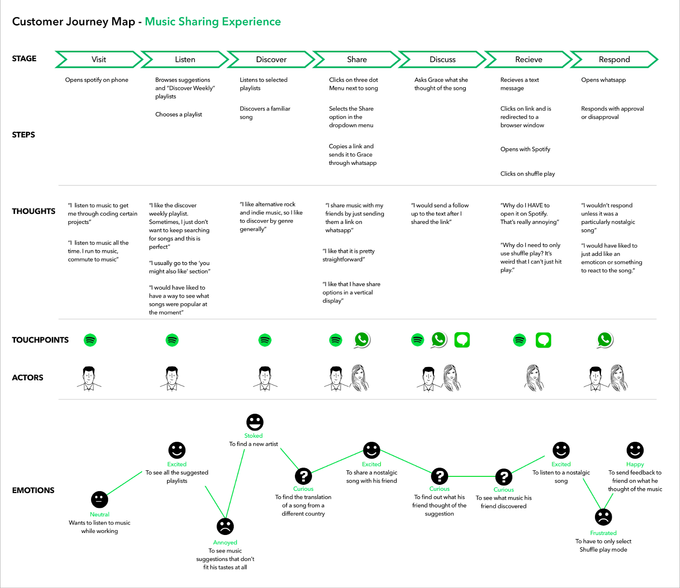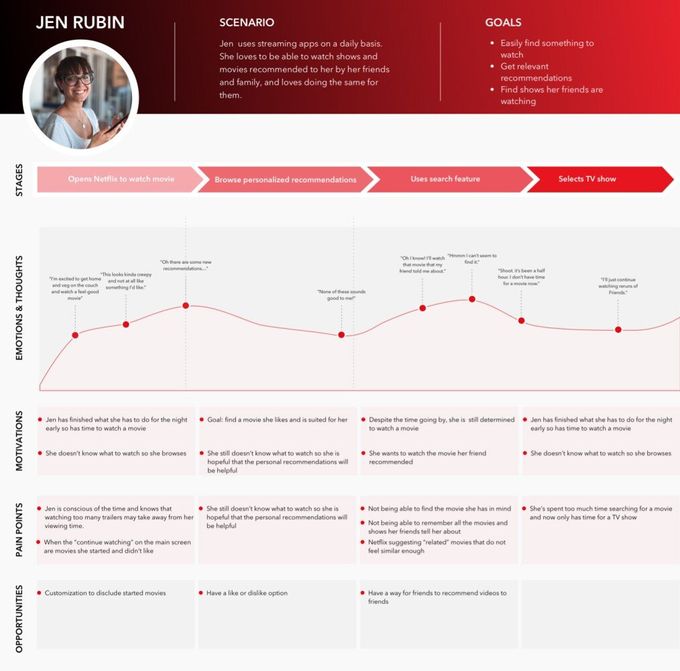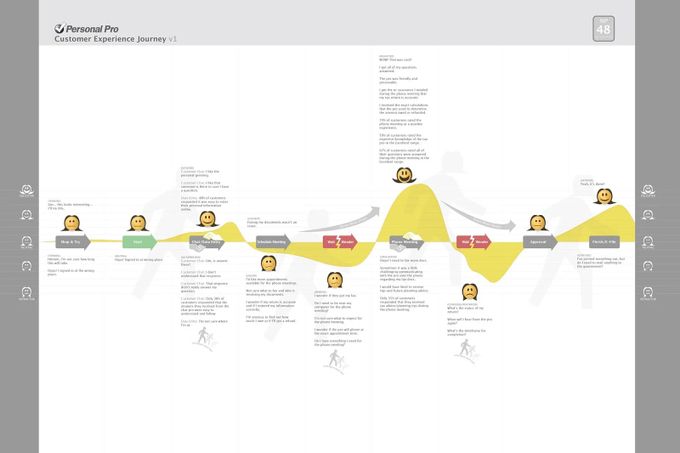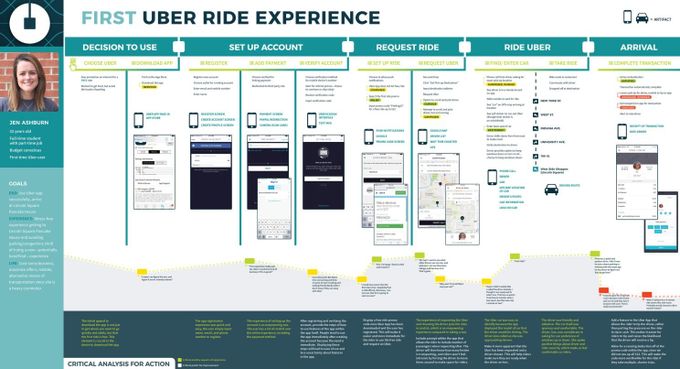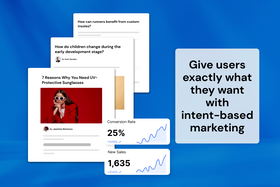Customer journey map: What it is and how to create one
Master the basics of customer journey mapping with our practical guide, complete with examples and templates to help you get started.
Published March 27, 2025

Customer journey maps help businesses visualize the entire customer experience, from first touchpoint to post-purchase interaction, revealing pain points and opportunities that might otherwise remain hidden.
In this guide, we'll explore what customer journey maps are, why they matter, and how to create effective ones that drive conversions and improve customer satisfaction.
Key takeaways
- A customer journey map visualizes the complete customer experience across all touchpoints with your brand.
- Effective journey mapping reveals pain points, opportunities, and gaps in the customer experience.
- Creating a journey map requires understanding your personas, touchpoints, and customer emotions.
- Different types of journey maps serve different business objectives—from current state analysis to future planning.
What is a customer journey map?
A customer journey map is a visual representation of every experience your customers have with your brand. Unlike a sales funnel that tracks movement toward purchase—a customer journey map documents the full spectrum of experiences, emotions, and touchpoints that happen before, during, and after a transaction.
Effective customer journey maps track:
- How people discover your brand
- What actions they take on your website or in-store
- Their emotional state throughout the journey
- Pain points and moments of delight
- What ultimately drives their purchase decisions
- Post-purchase interactions and opportunities
Customer journey map vs. user journey map
While often used interchangeably, customer journey maps and user journey maps have subtle but important differences.
- Customer journey maps: Look at the bigger picture of how customers interact with your brand everywhere—websites, stores, emails, phone calls, and social media. They track the complete relationship from first discovery to loyal customer, including how your internal business processes impact their experience.
- User journey maps: Focus specifically on how people interact with your website or app. They track the detailed steps users take when navigating digital products and highlight where they might get confused or frustrated. These maps are perfect for improving website experiences and making digital products easier to use.
» Discover the five stages of the user journey and how to nurture leads through each step.
Benefits of customer journey mapping
Taking the time to develop comprehensive customer journey maps offers several significant advantages:
1. Identifying pain points and opportunities
Customer journey maps expose moments in the conversion path where customers struggle or experience friction. By pinpointing these issues, you can prioritize improvements that create immediate impact.
Similarly, you'll discover moments of unexpected delight that can be amplified across the customer experience.
2. Breaking down organizational silos
Creating a customer journey map requires input from multiple departments—marketing, sales, customer service, product development, etc. This collaborative process helps align teams around a shared understanding of the customer experience. Plus, it fosters cross-departmental empathy and coordination.
3. Guiding resource allocation
With a clear visualization of the entire customer journey, businesses can make more informed decisions about where to invest their time and resources. Rather than guessing which improvements will have the biggest impact, you can focus on addressing the most significant pain points.
4. Building customer empathy
Customer journey mapping forces you to see experiences through your customers' eyes, helping teams develop greater empathy. This shift in perspective often leads to more customer-centric design and communication decisions.
5. Improving conversion rates and retention
By understanding exactly what drives customers toward or away from conversion, you can optimize these critical moments. Similarly, journey maps often reveal opportunities to strengthen post-purchase experiences, leading to higher retention rates and customer lifetime value.
» Perfect your conversion funnel to keep users coming back for more.
Key components of a customer journey map
For your customer journey map to be truly effective, it should include these essential elements:
1. Customer personas
Detailed customer personas form the foundation of your customer journey map. These should go beyond basic demographics to include:
- Goals and motivations
- Pain points and challenges
- Decision-making factors
- Communication preferences
- Typical behaviors and attitudes
The more detailed and evidence-based your personas, the more accurate and useful your customer journey map will be.
2. Customer journey stages
Break the customer journey into clear stages that represent the major phases customers move through. While these vary by business type, common stages include:
- Awareness: First discovering a need or problem
- Consideration: Researching potential solutions
- Decision: Evaluating specific options and making a choice
- Purchase: Completing the transaction
- Post-purchase: Using the product/service and seeking support
- Loyalty/advocacy: Becoming a repeat customer and recommending to others
3. Touchpoints and channels
Document every point of interaction between customers and your brand, including:
- Website visits
- Social media interactions
- Email communications
- Advertising exposures
- Store/office visits
- Customer service calls
- Product usage
Be comprehensive—customers don't experience these touchpoints in isolation but as parts of a connected journey.
» Learn to account for multiple touchpoints in the customer journey multi-touch attribution.
4. Customer emotions and mindsets
One of the most valuable aspects of journey mapping is capturing how customers feel at each stage. Document:
- Emotional states (confused, excited, frustrated, confident)
- Questions they're asking themselves
- Concerns or objections they might have
- Expectations for the next steps
These emotional insights often reveal the "why" behind customer behaviors that you won't get from data alone.
5. Pain points and opportunities
Highlight specific moments where customers struggle, feel frustrated, or abandon their journey. For each pain point, ask yourself:
- What exactly is happening?
- Why is it causing problems?
- How severely does it impact the customer experience?
Also, identify moments where you could exceed expectations by:
- Reducing steps in a process
- Providing helpful information before customers ask
- Adding personalized touches that show you understand their needs
- Creating memorable positive experiences that build loyalty
These detailed insights become your prioritized action list for improving the customer experience and driving better business results.
6. Internal ownership and metrics
For each touchpoint, identify:
- The team(s) responsible for that experience
- How success is measured at that stage
- Current performance against those metrics
This accountability mapping ensures that insights can be translated into specific team actions.
» Not sure which metrics matter most? Talk to our CRO experts about tracking what counts.
Types of customer journey maps
Different journey mapping approaches serve different strategic objectives. Here are the most common types to consider:
Current state maps
These document the journey as it exists today, based on research with actual customers. Current state maps are ideal for identifying immediate improvement opportunities and establishing a baseline for measuring future changes.
Future state maps
These visualize the ideal journey you want customers to experience after implementing improvements. Future state maps help align teams around a shared vision and guide development priorities.
Day-in-the-life maps
These capture the broader context of customers' lives beyond just interactions with your brand. By understanding what happens before and after engagement with your company, you can identify unmet needs and new opportunities.
Experience maps
These more general maps look at how people accomplish goals regardless of a specific brand or product. They're useful for understanding universal behaviors and expectations within a category.
Service blueprints
These extend journey maps by adding layers that show the behind-the-scenes operations, systems, and people that support each customer touchpoint. They're particularly valuable when improving service delivery or implementing organizational changes.
How to create a customer journey map
Follow these steps to develop effective customer journey maps.
1. Define your objectives
Start by clarifying what you hope to achieve with your customer journey map:
- Are you trying to improve a specific aspect of the customer experience?
- Do you want a holistic view of the entire journey or a focused view of one segment?
- Who will use this map, and what decisions will it inform?
Clear objectives will guide your approach and determine the appropriate type of journey map.
» Need help defining your marketing goals? Chat with an expert today.
2. Gather customer insights
Journey maps must be grounded in real customer data, not internal assumptions. Collect insights through:
- Customer interviews and shadowing
- Surveys and feedback analysis
- Website analytics and conversion data
- Customer service logs and recurring issues
- Social media listening and reviews
- Session recordings and usability testing
Combine quantitative data (what customers do) with qualitative insights (why they do it) for the most accurate picture.
» Track, measure, and attribute ROI across all your content pages with Entail CRO.
3. Create customer personas
Develop detailed personas based on your research, focusing on the most important customer segments for your business. Remember that different personas may have very different journeys, so you might need multiple maps.
4. Identify all touchpoints
List every way customers interact with your business across all channels. Be comprehensive—include both digital and physical touchpoints, as well as indirect interactions like seeing ads or reading reviews.
5. Map the current journey
For each persona, plot their journey through your identified stages. At each stage, document:
- Actions they take
- Thoughts and questions they have
- Emotions they experience
- Pain points they encounter
- Opportunities to improve
Use a timeline format that shows progression while allowing room for all these details.
6. Analyze and identify opportunities
With your current state map complete, look for patterns and insights:
- Where do customers experience the most negative emotions?
- At what points do they commonly drop off?
- Where are expectations not being met?
- What unnecessary steps or friction could be eliminated?
- Where could you add value or exceed expectations?
Prioritize these opportunities based on customer impact and business value.
» Want to optimize user journeys across your site? Book a consultation.
7. Create an action plan
Transform insights into a concrete improvement roadmap with:
- Specific changes to implement
- Teams responsible for each action
- Timeline for implementation
- Methods for measuring success
» Learn proven strategies to convert blog traffic into customers.
8. Test and iterate
Journey mapping isn't a one-time exercise. As you implement changes:
- Measure the impact on customer experience metrics
- Gather new feedback from customers
- Update your maps to reflect the evolving journey
- Identify the next set of improvements
This continuous improvement cycle ensures your customer experience keeps getting better over time.
» Learn how to conduct A/B tests in digital marketing.
Customer journey map examples
Let's examine some effective real-world customer journey maps that demonstrate different approaches and deliver tangible business results.
Example 1: Spotify's music-sharing experience
Source: Woompra
Spotify's journey map for enhancing music-sharing incorporated empathy mapping techniques to track not just user actions but also thoughts and feelings at each touchpoint. By combining data research with customer surveys, they identified emotional friction points in the sharing process.
This approach allowed them to make targeted improvements that felt natural to users, resulting in increased music sharing, higher satisfaction, and transforming regular users into brand advocates.
Example 2: Netflix's goal-oriented approach
Source: Five9
Netflix developed a distinctive customer journey map that focuses on specific goals at each touchpoint. Rather than just documenting the experience, their map deliberately incorporates sections for user motivations, pain points, and opportunities. This goal-oriented approach makes their map highly actionable.
By centering the map around a clearly defined target persona and specific scenarios, Netflix ensures that improvements directly address user needs and business objectives, creating a more focused roadmap for enhancing the streaming experience.
Example 3: TurboTax's Personal Pro launch
Source: Woompra
TurboTax used customer journey mapping during the launch of their Personal Pro product, combining data research, customer surveys, and professional tax preparer insights. Their map tracked the complete experience from the initial website visit through the entire tax filing process.
By identifying emotional low points and technical friction in the journey, TurboTax made targeted improvements to simplify complex tax concepts and provide better support at critical decision points.
Example 4: HubSpot's linear timeline approach
Source: HubSpot
HubSpot created a linear journey map that organized common customer experiences along a timeline, using color coding to highlight pain points and moments of delight. This straightforward format made the map easy to interpret and actionable across different teams.
What makes HubSpot's approach unique is the integration of actual customer testimonials categorized by journey stage. These firsthand accounts humanized the data and made identified issues more compelling and urgent for team members.
Example 5: Uber's comprehensive visual approach
Source: Insight6
Uber's journey map stands out by integrating app screenshots and visuals alongside standard elements like stages and emotions. Their well-defined persona and "critical analysis for action" section clearly highlight both strengths and areas for improvement at each step.
This visually rich approach helps product teams prioritize enhancements that directly impact the customer experience.
» Measure and optimize each step of the customer journey with Entail CRO.
Tools and templates for creating customer journey maps
You don't need to start from scratch when creating your journey maps. Consider these resources:
- Digital tools: Platforms like Miro, Figma, Canva, and UXPressia offer customer journey mapping templates and collaborative features.
- Spreadsheet templates: For a simpler approach, you can use Excel or Google Sheets templates like this one from Nielsen Norman Group.
- Journey mapping canvases: These printable customer journey mapping templates can guide the process in physical workshop settings.
Choose the format that best suits your team's collaboration style and the complexity of the journey you're mapping.
How to turn customer journey map insights into action
The true value of customer journey mapping isn't in creating pretty visualizations—it's in driving meaningful improvements to the customer experience. To ensure your journey maps create real impact:
- Share widely: Make sure all relevant teams see and understand the journey maps.
- Prioritize ruthlessly: Focus on fixing the most painful customer issues first.
- Measure results: Track how changes impact customer satisfaction and business metrics.
- Update regularly: Journey maps should be living documents that evolve as your business and customer expectations change.
By continuously refining your understanding of the customer journey and acting on those insights, you can create experiences that truly differentiate your brand in the marketplace.
Optimize every step of the customer journey
Creating effective customer journey maps is just the beginning. To truly enhance your customer experience, you need to optimize each touchpoint to guide users toward conversion while addressing their needs at every stage.
» Book a demo to see Entail CRO in action, or try it for free.

